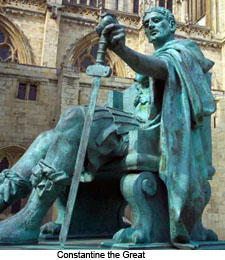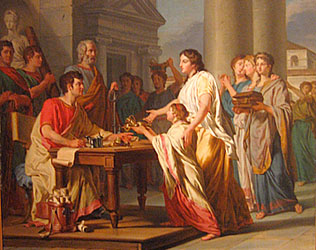August 2009 - Vol. 32
Years ago, I came across a children’s book that
told the history of the early Church in small words and in large,
brightly colored pictures. The first few centuries were pretty much distilled
into a few pages with a simple message, which I’ll summarize here:
If only evangelization were that simple. If only God would always make the gospel immediately relevant by raising a huge cross in the sky and thundering a command from above. If only he would transform our culture by the miraculous conversion of its most influential leaders, starting with the emperors of politics and culture. The truth, however, is that the Christianizing of the Roman Empire after Constantine was a messy affair – perhaps messier than it had been before, during the almost three centuries of persecution. The Eastern and Western lands went about the work of Christianizing in radically different ways; nasty disputes arose over the relationship between throne and altar; a rift appeared between East and West, which would eventually leave the Eastern peoples vulnerable to the rise of Islam and ultimately widen into a schism that tragically split the Church in two. So much for the storybook ending of a Christian empire. Yet the truth about the early Christians is more exciting, more instructive, and even more miraculous than the storybooks convey. It is a story not so much about emperors and armies as about families and how they changed the world. Astonishing Growth
These were not 33 million “nominal” Christians – not 33 million “cafeteria Catholics” and “chaplain to the culture” Protestants. They could not be. They did not have the luxury of being lukewarm. In the decade before Constantine’s edict, the Church had suffered its most ruthless and systematic persecution ever under the emperor Diocletian and his successors. The practice of the faith was, in many places, punished by torture and death. In many places, to live as a Christian meant, at the least, to accept social stigma and humiliation. What is more, the Christian way itself was characterized by demanding disciplines in the life of prayer and in the moral life. To be a Christian was not easy in the year 300. It cost something. Whether or not you were martyred, you had to pay with your life. Christians were laying their lives on the line every time they attended the liturgy, and they continued to do so through the course of every day. Yet the rate of conversion throughout the empire – beginning with the first Christians, long before Constantine – was most remarkable. A few years ago, an eminent sociologist, Rodney Stark of the University of Washington, set out to track church growth in the ancient world. He gathered his findings in The Rise of Christianity. Dr. Stark is not a Christian and had no vested interest in making Christianity look good. What Stark found in his study of the first Christian centuries was an astonishing growth rate of 40 percent per decade. Again, Constantine gets no credit for this growth. Most of it happened in the years before he was born. In fact, even though conversions were coerced at various times after the year 380, the Church never again witnessed the kind of growth that took place when conversions were costly.
Stark holds that most growth came from individual conversions, and not only from the poor, but also from the merchant and upper classes. He argues that most converts were women, that women benefited greatly from conversion, and that some women – though never ordained to the priesthood – were influential leaders. Using historical data and sociological methods, he argues that the Christian population grew by 40 percent a decade, from about 1,000 Christians in the year 40 to 7,530 in 100 to a little over six million in 300 and 33 million in 350 – growing, in the hundred years between 250 and 350, from about two percent of the population to slightly over half. Go to > Next Page | 1 | 2 | 3 | 4 | 5
|
. | |
|
(c) copyright 2009 The Sword of the Spirit publishing address: Park Royal Business Centre, 9-17 Park Royal Road, Suite 108, London NW10 7LQ, United Kingdom email: living.bulwark@yahoo.com |
. |


